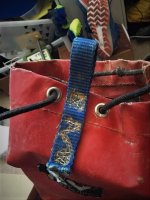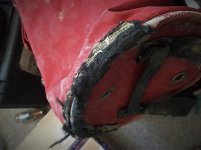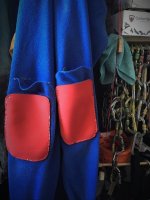AlexR
Active member
The Speedy Stitcher is great, and although Phil's drill method sounds cool I'm lazy and have just always used a sewing machine bobbin (which I "load" on the sewing machine). It holds less thread than the spool the stitcher comes with, but that's not really a limiting factor on the stitcher.
I'd say the stitcher and a sewing machine do pretty different things (for me), although it's possible to e.g. replace the velcro on an AV using the stitcher, you'll be there a good while. I definitely was. Conversely, there's not a chance in hell my puny sewing machine could do anything with a tackle sack.
Stitcher:
Really good for small fixes in thick material and hard to get to places; e.g. webbing attachment or bottom of a tackle sack. Punches through absolutely everything, including your hand. The pantin fix below is a good example, though I should have left way more webbing between the stitches in picture 1. Also fixed bouldering mats, knee pads, put an extra attachment loop on my tackle sack, stuff like that.
In my experience the stitching has always outlived the surrounding material, case in point the bottom of the AV tackle sack in the picture below.
Sewing machine:
You'll wish you had one as soon as it comes to stitching longer stretches, e.g. crampon ripped bottom 3rd of trousers, changing velcro on caving suit, etc.
This might not be a problem with a decent sewing machine, but with my AEG plastic fantastic (I think it's this one) it takes me quite a long time & scrap material to find out the correct upper and lower thread tension plus some experimenting with stitch length to get an ok stitch out with thicker threads. Even with a thick needle the machine just doesn't like thick threads. I've had some success with using a thicker upper thread and thinner bottom thread.
Some of this fiddling got me pretty close to throwing the machine out of the window.
I'd say the stitcher and a sewing machine do pretty different things (for me), although it's possible to e.g. replace the velcro on an AV using the stitcher, you'll be there a good while. I definitely was. Conversely, there's not a chance in hell my puny sewing machine could do anything with a tackle sack.
Stitcher:
Really good for small fixes in thick material and hard to get to places; e.g. webbing attachment or bottom of a tackle sack. Punches through absolutely everything, including your hand. The pantin fix below is a good example, though I should have left way more webbing between the stitches in picture 1. Also fixed bouldering mats, knee pads, put an extra attachment loop on my tackle sack, stuff like that.
In my experience the stitching has always outlived the surrounding material, case in point the bottom of the AV tackle sack in the picture below.
Sewing machine:
You'll wish you had one as soon as it comes to stitching longer stretches, e.g. crampon ripped bottom 3rd of trousers, changing velcro on caving suit, etc.
This might not be a problem with a decent sewing machine, but with my AEG plastic fantastic (I think it's this one) it takes me quite a long time & scrap material to find out the correct upper and lower thread tension plus some experimenting with stitch length to get an ok stitch out with thicker threads. Even with a thick needle the machine just doesn't like thick threads. I've had some success with using a thicker upper thread and thinner bottom thread.
Some of this fiddling got me pretty close to throwing the machine out of the window.







